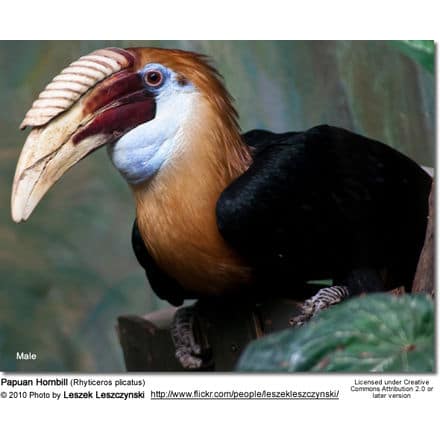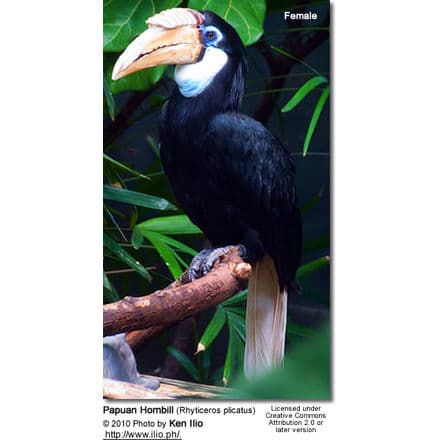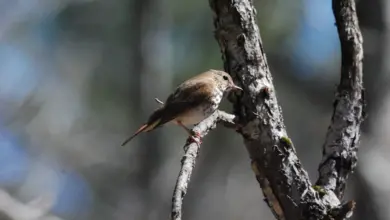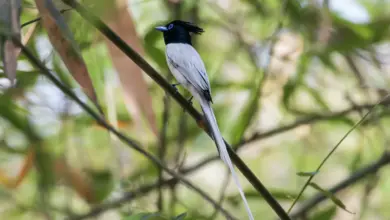Papuan Hornbills or Blyth’s Hornbills
The Papuan Hornbills (Rhyticeros plicatus) is also known as Blyth’s Hornbill. Its local name in Tok Pisin is kokomo. It is a large hornbill species inhabiting the forest canopy in the Wallacea and Melanesia.
Previously, this hornbill was placed in the genus Aceros. It has in the past been often lumped with the Plain-pouched Hornbill (R. subruficollis), and sometimes considered to include the Narcondam Hornbill (R. narcondami) and the Wreathed Hornbill (R. undulatus) as subspecies.
Description
Up to 91 cm in length, the adult male has mainly black plumage with a golden or orange-buff-colored head, white throat, and a white tail.
Its irises are reddish brown, surrounded by naked pale blue skin around the eye. The female is a smaller predominantly black bird with a white throat and tail. Both sexes have a very large, horn-colored, bill and casque (a large display growth on the upper bill). Both sexes of young birds resemble the male. Adults have up to eight folds on the pale casque, depending on age, while young birds have none.
In flight the sound of its wings is loud and distinctive, a rushing noise that has been compared to the sound of steam escaping from a steam locomotive. As well as the noise produced by its wings, the Papuan Hornbill has a range of far-reaching, guttural grunting and laughing calls.
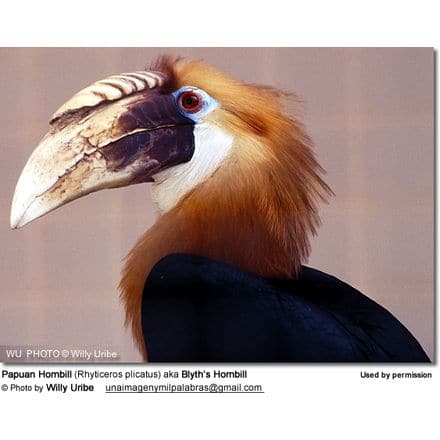
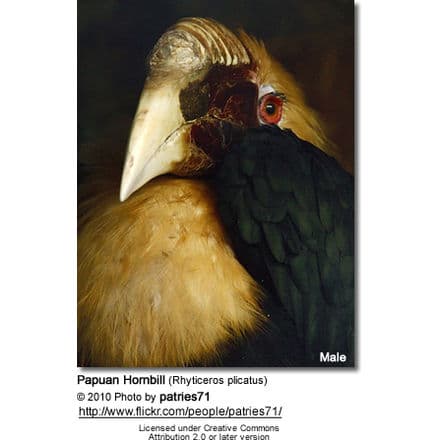
Subspecies
Various subspecies have been described across its range:
- R. p. plicatus (Forster, 1781) – South Moluccas
- R. p. ruficollis (Vieillot, 1816) – North Moluccas and West Papua, eastwards to the Southern Highlands and Simbu Province, Papua New Guinea
- R. p. jungei Mayr, 1937 – Eastern New Guinea, west as far as the Fly River region
- R. p. dampieri Mayr, 1934 – Bismarck Archipelago
- R. p. harterti Mayr, 1934 – Bougainville and Buka Islands
- R. p. mendanae Hartert, 1924 – Solomon Islands from Choiseul to Guadalcanal and Malaita
Distribution
The Papuan Hornbills occurs throughout lowland forests, from sea level up to 1,200-1,500 m Above mean sea level (ASL), in the Moluccas, New Guinea, the Bismarck Archipelago, and as far east as the Solomon Islands. It is the only hornbill species native to New Guinea, and one of the largest flying birds of the region.
Diet / Feeding
Its diet consists mainly of fruits – especially Figs (Ficus) –, occasionally supplemented with insects and other small animals.

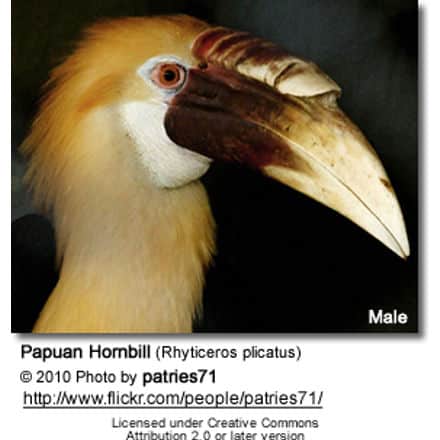
Breeding
The Papuan Hornbills nests in a large rainforest tree hollow from 18 m to at least 30 m above the ground.
The female is restricted to the nest cavity throughout the incubation and nestling period, being largely sealed within with the entrance plastered up by a mixture of fruit pulp and rotten wood, leaving only a narrow aperture through which she is fed by the male.
The clutch size is about two eggs.
Status and relationship with humans
Still widespread throughout its large habitat range, the Papuan Hornbill is evaluated as a Species of Least Concern on the IUCN Red List of Threatened Species.
However, it is subject to hunting pressure by some tribal groups, with its feathers used in headdresses, its bill being valued as a personal adornment, and the lower mandible used as a spear point. As a consequence, it is becoming rarer in some areas of New Guinea. On the other hand, this species has withstood tens of millennia of human hunting pressure, so as long as sufficient habitat is preserved, it is unlikely that hunting alone is a significant threat.
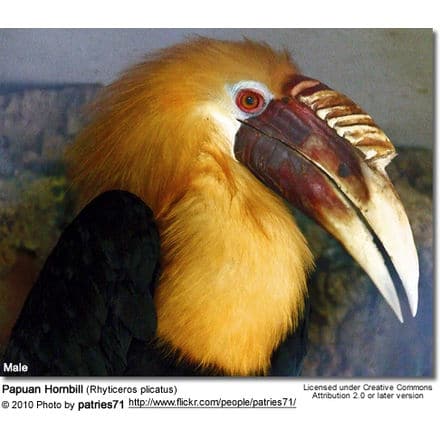
References
- BirdLife International (2008). Aceros plicatus. In: IUCN Red List 2008. IUCN Red List of Threatened Species. Downloaded on 31 May 2009.
- Coates, Brian J. (1985): The Birds of Papua New Guinea (Vol.1: Non-Passerines). Dove Publications, Alderley, Queensland, Australia. ISBN 0-9590257-0-7
- Coates, Brian J. and Bishop, K. David (1997): A Guide to the Birds of Wallacea, Sulawesi, the Moluccas and Lesser Sunda Islands, Indonesia. Dove Publications, Alderley, Queensland, Australia. ISBN 0-9590257-3-1
- Majnep, Ian Saem and Bulmer, Ralph (1977): Birds of my Kalam Country. Auckland University Press, Auckland, New Zealand.
- Rasmussen, Pamela C. (2000): A review of the taxonomy and status of the Plain-pouched Hornbill Aceros subruficollis. Forktail 16: 83-86.
- Steadman, David William (2006): Extinction and Biography of Tropical Pacific Birds. University of Chicago Press. ISBN 0226771423
Hornbill Information … Hornbill Index of Species … Hornbill Species Photo Gallery
